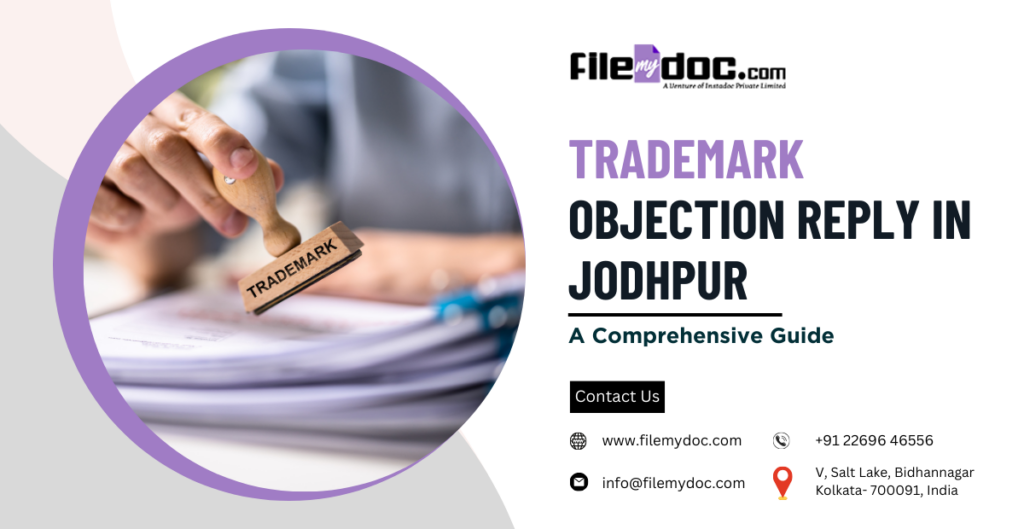Trademark Objection Reply in Jodhpur : A Comprehensive Guide
Introduction
In the realm of intellectual property rights, responding to trademark objections is a crucial process to safeguard your brand identity and market presence. This article explores the intricacies of preparing a compelling trademark objection reply specifically tailored for submissions in Jodhpur.




Understanding Trademark Objection
What Constitutes a Trademark Objection?
A trademark objection arises when the Registrar of Trademarks in Jodhpur raises concerns about the registration application. It can stem from various grounds such as similarity to existing trademarks or lack of distinctiveness.
Importance of Addressing Trademark Objections
Resolving objections promptly is vital to prevent delays in trademark registration and legal disputes. It ensures that your brand enjoys exclusive rights and protection under the law.
Legal Framework for Trademark Objections in India
Overview of Indian Trademark Law
The Indian Trademarks Act, 1999, governs trademark registration and objections. It provides a framework for the protection of distinctive marks and intellectual property rights.
Role of Trademark Registry in Jodhpur
The Jodhpur Trademark Registry plays a pivotal role in administering trademark applications and objections within its jurisdiction.
Steps to Prepare a Trademark Objection Reply
Gathering Necessary Information
Begin by collecting all relevant documents, including the objection notice and your trademark application details.
Analyzing the Objection Notice
Carefully review the grounds cited in the objection notice to understand the Registrar’s concerns.
Formulating a Response Strategy
Devise a strategic approach to address each objection point-by-point, supported by legal rationale and evidence.
Key Components of an Effective Reply
Clear Identification of Grounds
Clearly outline and rebut each objection raised, demonstrating a thorough understanding of the issues at hand.
Legal Justification and Precedents
Support your arguments with legal precedents and case laws to strengthen the validity of your response.
Supporting Evidence and Documentation
Include relevant evidence such as market surveys, product samples, or consumer testimonials to substantiate your claims.
Writing the Trademark Objection Reply
Structuring the Response
Organize your reply into sections corresponding to each objection, ensuring clarity and coherence throughout.
Language and Tone Considerations
Maintain a professional and respectful tone, emphasizing the merits of your trademark while addressing concerns diplomatically.
Common Pitfalls to Avoid
Avoid factual inaccuracies, ambiguous statements, or emotional appeals that may weaken your case.
Submitting the Reply to the Trademark Registry
Procedure and Timelines
Adhere to the specified timelines for submitting your reply to avoid procedural setbacks.
Follow-Up Actions
Stay proactive by following up with the Registry and addressing any additional queries or requests promptly.
FAQs
Q.1 What is a trademark objection?
A trademark objection is a formal notice from the Trademark Registry questioning the eligibility of your trademark for registration.
Q.2 How long do I have to respond to a trademark objection?
You typically have 30 days from the date of receiving the objection notice to submit your reply.
Q.3 Can I handle the objection reply process myself?
While possible, it’s advisable to seek legal assistance to navigate the complexities and maximize your chances of success.
Q.4 What happens if my reply is rejected?
If your reply is rejected, you may appeal the decision or revise your application based on feedback provided.
Q.5 Is it possible to appeal against a rejection?
Yes, you can appeal to the Intellectual Property Appellate Board (IPAB) against the Registrar’s decision within the prescribed period.
Conclusion
Navigating the process of responding to trademark objections in Jodhpur requires diligence, strategic planning, and adherence to legal guidelines. By crafting a well-structured and persuasive objection reply, businesses can protect their trademarks effectively and maintain their competitive edge in the market.




























